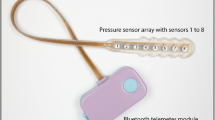Abstract
Introduction and hypothesis
A wireless intravaginal pressure sensor (IVPS) has been developed to quantify abdominal pressure (Pabd) changes during exercise and activities of daily living to guide post-operative advice given to women. In this pilot study, we aimed to compare IVPS performance, comfort, retention, and acceptability to a standard fluid-filled intrarectal pressure catheter currently used to measure Pabd during routine urodynamics.
Methods
A Life-Tech 3-mm urodynamic intrarectal catheter and IVPS were inserted concurrently in volunteers attending a urodynamics clinic. The IVPS was positioned above the levator plate and the intrarectal catheter positioned in routine fashion well above the anal sphincter. Routine urodynamics was undertaken, with women asked to perform star jumps if coughing or Valsalva did not invoke leakage. Subjects rated device comfort using a visual analogue scale (0–10). Repeated measures Bland-Altman analysis determined level of agreement (LOA) between the two devices for peak pressures for each activity.
Results
Twenty-seven women were recruited, 67 % of the participants preferred the IVPS, 18 % the intrarectal catheter, while 15 % had no preference. Mean comfort score was 0.9 ± 1.7 and 2.1 ± 2.6 (p = 0.049) for the IVPS and intrarectal catheter respectively. Bland-Altman analysis demonstrated minimal bias for cough and Valsalva, however LOA were wide. Differences were more prominent during star jumps where rapid dynamic pressure changes occurred.
Conclusions
The IVPS had a higher comfort score and was well retained. The LOA between the two systems was moderate, but the high sampling rate and lower susceptibility to motion artefacts of the IVPS may provide more accurate information that will be important clinically.



Similar content being viewed by others
References
Nygaard I, Barber MD, Burgio KL, Kenton K, Meikle S, Schaffer J, Spino C, Whitehead WE, Wu J, Brody DJ et al (2008) Prevalence of symptomatic pelvic floor disorders in US women. JAMA 300(11):1311–1316
DeLancey JO, Kane Low L, Miller JM, Patel DA, Tumbarello JA (2008) Graphic integration of causal factors of pelvic floor disorders: an integrated life span model. Am J Obstet Gynecol 199(6):610.e1–610.e5
Olsen AL, Smith VJ, Bergstrom JO, Colling JC, Clark AL (1997) Epidemiology of surgically managed pelvic organ prolapse and urinary incontinence. Obstet Gynecol 89(4):501–506. doi:10.1016/S0029-7844(97)00058-6
Glazener C, Elders A, MacArthur C, Lancashire R, Herbison P, Hagen S, Dean N, Bain C, Toozs‐Hobson P, Richardson K et al (2013) Childbirth and prolapse: long-term associations with the symptoms and objective measurement of pelvic organ prolapse. BJOG 120(2):161–168
Weir LF, Nygaard IE, Wilken J, Brandt D, Janz KF (2006) Postoperative activity restrictions: any evidence? Obstet Gynecol 107(2 Pt 1):305–309
Guttormson R, Tschirhart J, Boysen D, Martinson K (2008) Are postoperative activity restrictions evidence-based? Am J Surg 195(3):401–404
World Health Organization (2012) Global recommendations on physical activity for health. WHO, Geneva
Mens J, Hoek van Dijke G, Pool-Goudzwaard A, van der Hulst V, Stam H (2006) Possible harmful effects of high intra-abdominal pressure on the pelvic girdle. J Biomech 39(4):627–635
O′Dell KK, Morse AN, Crawford SL, Howard A (2007) Vaginal pressure during lifting, floor exercises, jogging, and use of hydraulic exercise machines. Int Urogynecol J Pelvic Floor Dysfunct 18(12):1481–1489
Kruger J, Hayward L, Nielsen P, Loiselle D, Kirton R (2013) Design and development of a novel intra-vaginal pressure sensor. Int Urogynecol J 24:1715–1721. doi:10.1007/s00192-013-2097-8
Bland JM, Altman DG (1986) Statistical methods for assessing agreement between two methods of clinical measurement. Lancet 1(8476):307–310
Constantinou CE, Omata S, Yoshimura Y, Peng Q (2007) Evaluation of the dynamic responses of female pelvic floor using a novel vaginal probe. Ann N Y Acad Sci 1101:297–315. doi:10.1196/annals.1389.020
Hundley A, Brown M, Brubaker L, Cundiff G, Kreder K, Lotze P, Richter H, Zyczynski H, Weber A, Visco A (2006) A multicentered comparison of measurements obtained with microtip and external water pressure transducers. Int Urogynecol J Pelvic Floor Dysfunct 17(4):400–406. doi:10.1007/s00192-005-0027-0
Hogan S, Gammie A, Abrams P (2012) Urodynamic features and artefacts. Neurourol Urodyn 31(7):1104–1117. doi:10.1002/nau.22209
Hsu Y, Coleman TJ, Hitchcock RW, Heintz K, Shaw JM, Nygaard IE (2012) Clinical evaluation of a wireless intra-vaginal pressure transducer. Int Urogynecol J 23(12):1741–1747. doi:10.1007/s00192-012-1811-2
Coleman TJ, Thomsen JC, Maass SD, Hsu Y, Nygaard IE, Hitchcock RW (2012) Development of a wireless intra-vaginal transducer for monitoring intra-abdominal pressure in women. Biomed Microdevices 14(2):347–355. doi:10.1007/s10544-011-9611-x
Rosenbluth EM, Johnson PJ, Hitchcock RW, Nygaard IE (2010) Development and testing of a vaginal pressure sensor to measure intra-abdominal pressure in women. Neurourol Urodyn 29(4):532–535
Johnson PJ, Rosenbluth EM, Nygaard IE, Parikh MK, Hitchcock RW (2009) Development of a novel intra-vaginal transducer with improved dynamic response. Biomed Microdevices 11(6):1213–1221. doi:10.1007/s10544-009-9339-z
Bhatia NN, Bergman A (1986) Urodynamic appraisal of vaginal versus rectal pressure recordings as indication of intra-abdominal pressure changes. Urology 27(5):482–485
McCarthy TA (1982) Validity of rectal pressure measurements as indication of intra-abdominal pressure changes during urodynamic evaluation. Urology 20(6):657–660
Richardson DA (1985) Use of vaginal pressure measurements in urodynamic testing. Obstet Gynecol 66(4):581–584
Cobb WS, Burns JM, Kercher KW, Matthews BD, James Norton H, Todd Heniford B (2005) Normal Intraabdominal Pressure in Healthy Adults. J Surg Res 129(2):231–235. doi:10.1016/j.jss.2005.06.015
Hendrix SL, Clark A, Nygaard I, Aragaki A, Barnabei V, McTiernan A (2002) Pelvic organ prolapse in the Women’s Health Initiative: gravity and gravidity. Am J Obstet Gynecol 186(6):1160–1166
Cooper M, Fletter P, Zaszczurynski P, Damaser M (2011) Comparison of air-charged and water-filled urodynamic pressure measurement catheters. Neurourol Urodyn 30(3):329–334
Digesu GA, Derpapas A, Robshaw P, Vijaya G, Hendricken C, Khullar V (2014) Are the measurements of water-filled and air-charged catheters the same in urodynamics? Int Urogynecol J 25(1):123–130
Acknowledgments
The authors would like to thank Millar Instruments for assistance with pressure measurement equipment and all the participants who gave their consent for this study. The study was supported by the Aoteoroa Foundation Postdoctoral Research Fellowship.
Conflicts of interest
None.
Author information
Authors and Affiliations
Corresponding author
Rights and permissions
About this article
Cite this article
Arora, A.S., Kruger, J.A., Budgett, D.M. et al. Clinical evaluation of a high-fidelity wireless intravaginal pressure sensor. Int Urogynecol J 26, 243–249 (2015). https://doi.org/10.1007/s00192-014-2500-0
Received:
Accepted:
Published:
Issue Date:
DOI: https://doi.org/10.1007/s00192-014-2500-0




